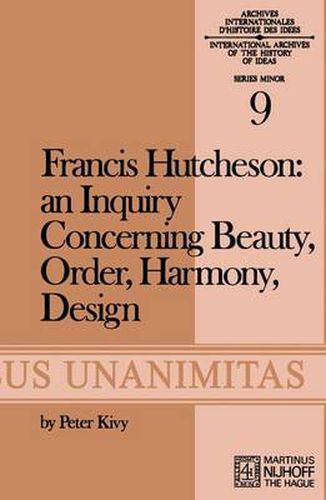Readings Newsletter
Become a Readings Member to make your shopping experience even easier.
Sign in or sign up for free!
You’re not far away from qualifying for FREE standard shipping within Australia
You’ve qualified for FREE standard shipping within Australia
The cart is loading…






This title is printed to order. This book may have been self-published. If so, we cannot guarantee the quality of the content. In the main most books will have gone through the editing process however some may not. We therefore suggest that you be aware of this before ordering this book. If in doubt check either the author or publisher’s details as we are unable to accept any returns unless they are faulty. Please contact us if you have any questions.
THE SENSE OF BEAUTY: A FIRST APPROXIMATION It is generally acknowledged that during the first half of the eighteenth century a profound change was wrought in the theory of art and natural beauty. To this period we owe the establishment of the modem system of the arts. 1 In England, the notion of a separate and autonomous disci pline devoted solely to art and to beauty came into being through the concept of aesthetic disinterestedness.
2 In addition, emphasis in the theory of art shifted from object to subject - from the work of art to the perceiver and critic. Focal point for this change was the sense of beauty which, in concert with the moral sense of the British school, represented a dominant force in Enlightenment value theory. It is Francis Hutcheson who, more than anyone else, can be thought of as the founder and principal spokesman of this philosophical coterie. If the aesthetic sense was instrumental in the transfer of interest, in the philosophy of art, from object to perceiver, the aesthetic and moral senses together were no less important in a parallel transference of value judgment from the rational to the sensate.
$9.00 standard shipping within Australia
FREE standard shipping within Australia for orders over $100.00
Express & International shipping calculated at checkout
This title is printed to order. This book may have been self-published. If so, we cannot guarantee the quality of the content. In the main most books will have gone through the editing process however some may not. We therefore suggest that you be aware of this before ordering this book. If in doubt check either the author or publisher’s details as we are unable to accept any returns unless they are faulty. Please contact us if you have any questions.
THE SENSE OF BEAUTY: A FIRST APPROXIMATION It is generally acknowledged that during the first half of the eighteenth century a profound change was wrought in the theory of art and natural beauty. To this period we owe the establishment of the modem system of the arts. 1 In England, the notion of a separate and autonomous disci pline devoted solely to art and to beauty came into being through the concept of aesthetic disinterestedness.
2 In addition, emphasis in the theory of art shifted from object to subject - from the work of art to the perceiver and critic. Focal point for this change was the sense of beauty which, in concert with the moral sense of the British school, represented a dominant force in Enlightenment value theory. It is Francis Hutcheson who, more than anyone else, can be thought of as the founder and principal spokesman of this philosophical coterie. If the aesthetic sense was instrumental in the transfer of interest, in the philosophy of art, from object to perceiver, the aesthetic and moral senses together were no less important in a parallel transference of value judgment from the rational to the sensate.